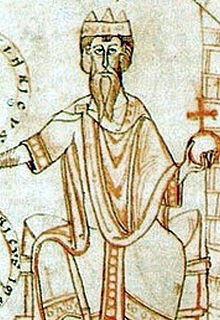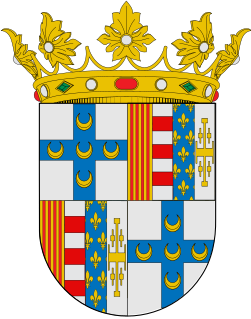
Conrad II, also known as Conrad the Elder and Conrad the Salic, was Emperor of the Holy Roman Empire from 1027 until his death in 1039. The first of a succession of four Salian emperors, who reigned for one century until 1125, Conrad also served as King of Germany from 1024, King of Italy from 1026, and King of Burgundy (Arelat) from 1033.

The Duchy of Gaeta was an early medieval state centered on the coastal South Italian city of Gaeta. It began in the early ninth century as the local community began to grow autonomous as Byzantine power lagged in the Mediterranean and the peninsula due to Lombard and Saracen incursions.

The Duchy of Naples began as a Byzantine province that was constituted in the seventh century, in the reduced coastal lands that the Lombards had not conquered during their invasion of Italy in the sixth century. It was governed by a military commander (dux), and rapidly became a de facto independent state, lasting more than five centuries during the Early and High Middle Ages. The modern city of Naples remains a significant region of Italy, today.

John Stewart, Duke of Albany was regent of the Kingdom of Scotland, Duke of Albany in peerage of Scotland and Count of Auvergne and Lauraguais in France.
Ernest II was Duke of Swabia from 1015 to 1030. A member of the Babenberg family, he was the son of Ernest I and Gisela of Swabia.

Medieval Amalfi was ruled, in the tenth and eleventh centuries, by a series of dukes, sometimes called dogi, corresponding with the republic of Venice, a maritime rival throughout the Middle Ages. Before the title of Duke of Amalfi was formally established in 957, various patricians governed the territory. Amalfi established itself as one of the earliest maritime trading powers renowned throughout the Mediterranean, considered for two centuries, the most powerful of the maritime republics.
Richard III, also known as Richard of Caleno, was the Norman count of Carinola and last quasi-independent Duke of Gaeta, ruling from 1121 to his death. From 1113, he was regent of Gaeta for his cousin or nephew, Duke Jonathan; in 1121 he succeeded him. As duke he was a nominal vassal of the Princes of Capua, to whom he was related.
John V was the consul and duke of Gaeta from 1012 to 1032. He was the son of John IV and Sichelgaita, sister of Sergius IV of Naples. He was either very young when he succeeded his father or perhaps he was even born posthumously.
Emilia was the duchess of Gaeta first as consort of John III (984–1008) and then as the regent for her grandson John V (1012–1032) until at least 1029.
Leo II was the Duke of Gaeta briefly in early 1042. He was the last duke of the native Docibilan family. His father was the magnificus Docibilis, a grandson of Duke Gregory. His brother, Hugh, was the count of Suio.
John III was the consul and duke of Gaeta from some time between October 984 and January 986 until his death.
John IV was the eldest son of John III of Gaeta who was appointed co-duke in 991 while still young. John succeeded his father in 1008 or 1009 and ruled for a brief four years.
Marinus I was probably a Hypatus of Gaeta in association with his father from 839 or thereabouts until he disappears from records abruptly in 866. From the abruptness of his disappearance, he and his father are often supposed to have been deposed violently by their successor Docibilis I. Marinus witnessed his father's land grants in 839 and later records give him the title comes. It has been suggested that a prefect of the name Kampulus was his son.

Gisela of Swabia, a member of the Conradiner dynasty, was queen of Germany from 1024 to 1039 and empress of the Holy Roman Empire from 1027 to 1039 by her third marriage with Emperor Conrad II. She was the mother of Emperor Henry III. She was regent of Swabia for her minor son Duke Ernest II of Swabia in 1015.

The Norman conquest of southern Italy, also known as The Kingdom In The Sun, lasted from 999 to 1139, involving many battles and independent conquerors.
Jonathan, a member of a cadet branch of the Drengot family, was the Duke of Gaeta from 1113 until his death. He is known from the Codex Caietanus to have been in the fourth year of his minority in 1116 and the seventh of his rule in 1119. There are three theories of his paternity. He may have been the son of Count Jonathan I of Carinola or his grandson by an unnamed son, or else the grandson of Count Bartholomew of Carinola. He was under the regency of his cousin or uncle, Count Richard of Carinola.
Gualganus, surnamed Ridel, was the third and last Count of Pontecorvo and Duke of Gaeta of the Norman Ridel family from about 1091 until about 1103. He was a son and successor of Duke Raynald Ridel, but his rule in Gaeta was not unopposed.
Hugh was the Count of Suio in the Duchy of Gaeta. He was probably a son of Docibilis magnificus, who in turn was probably a son of Landolf, son of Gregory, Duke of Gaeta, and Landolf's mistress Polyssena (Pulessene). He was a brother of Duke Leo II of Gaeta.
Bernard was the Bishop of Gaeta for fifty years from his appointment in 997 until his death. He was a member of the Docibilan dynasty which ruled the Duchy of Gaeta from 867 to 1032. During his long episcopate he achieved the economic security of his see in the face of labour difficulties, annexed the diocese of Traetto to his own in or soon after 999, and witnessed the decline and replacement of his family in Gaeta.